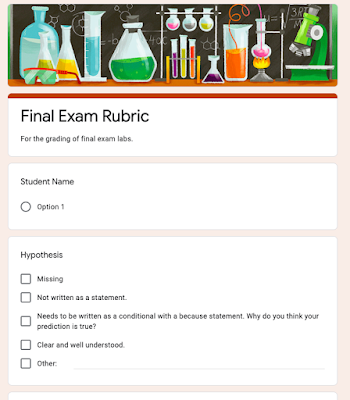Since my AP Biology class is also a dual enrollment class, I have to give a final exam. Usually, the exam they take is a set of multiple choice questions and free response questions...similar to the AP Bio exam format. Of course, this year, we were remote for final exams. Our administration encouraged us to give exams that could be open notes and even open internet. Initially, I was not excited about having to come up with a new final exam. Although most of my students were doing fine with the honor system with online tests, I had a couple of students who were cheating. I felt like I needed to give an option that made it fair for all of the students and decided to go with a task exam.
I have known about Jon Darkow's website filled with simulation models that correlate to AP Bio content, but I do so many hands-on labs/activities in class that I've not seen it as a necessity. Then we went all remote and all of a sudden, these simulations became a life-saver! We did a couple together in class for labs. They really get the students thinking about what is going on in biological systems.
As I thought about the final, I began thinking about what I want students to be able to DO once they were finished with the class. I wanted them to be able to design an experiment and to be able to analyze data. I'm hoping that some of the content will stick with them as well, but that is really secondary to being able to practice science. In the end, I decided that for their final, I would ask them to perform two experiments. They would be able to showcase their ability to form a hypothesis, test it, organize the data in a meaningful way, analyze the data and draw some conclusions.
The final is one google doc and a google sheet. The document itself has links to five simulations that they could choose from for Experiment #1 that included topics from the first semester, and then links to five other simulations that they could choose from for Experiment #2 that included topics from the second semester. I shared copies of them in Google Classroom so I would be able to see not only their written answers, but the data in the table and their graphs. I like that better than tables and graphs pasted into the google doc itself. By the time I made the final, I had discovered the beauty of adding a one-celled table as an answer blank. It makes it so much easier to find students' answers, especially if they type answers in the same font and color as my original document.
I decided that I'd grade their final using the same method I grade their formal lab reports. I made a google form that I enter comments into for each part of their exam lab. Then I use the add-on "Autocrat" to make an organized document for each student with my comments and the grade. I actually liked this final so much that I'm planning to use it every year, even if we are face-to-face.
AP Bio Final Exam (I removed the links to the simulations since I'm not sure which ones I'll use next year, and don't want them out there for my students to find.)
Google Sheet for data and graphs (I made a tab for each experiment)
Google Form Grading Rubric (In the name question, I usually copy and paste my class list, so I just have to chose the name when I'm grading the exam.)
The Google Form will populate a spreadsheet with all of your comments to students, but I insert this formula at the end of the row to calculate the final score (to match the point values on the final to my rubric scores):
=D2+F2+H2+J2*1.5+L2*3.5+N2*4.5+P2+R2+T2+V2*1.5+X2*3.5+Z2*4.5
Template for Final Score using Autocrat Once I have Sheets calculate the final scores for everyone, I run Autocrat, which uses this template to put all of my comments into an easy to read document.









